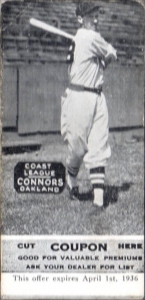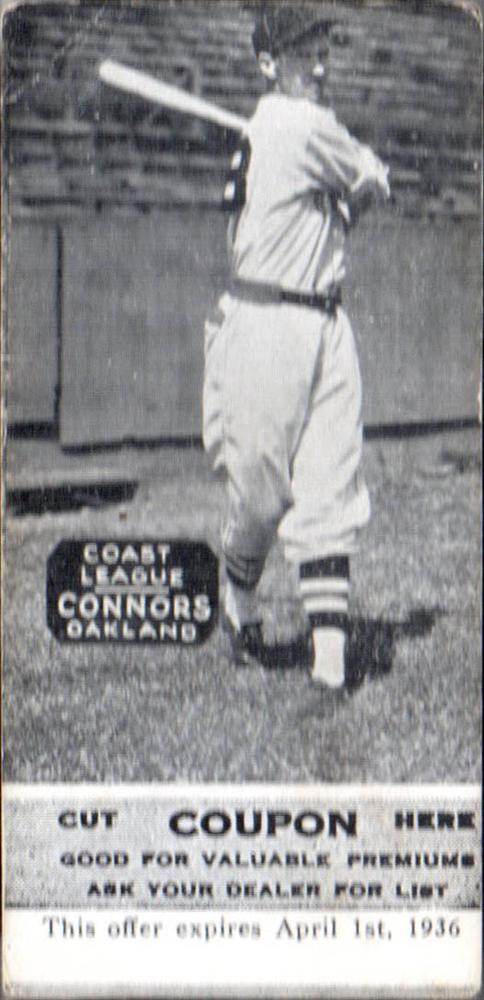September 17, 1938: Merv Connors becomes first White Sox player to hit 3 homers in game at Comiskey Park
 Home Runs and Comiskey Park. Those two didn’t mix much for most of the ballpark’s 80-year existence. When it opened it 1910, the Base Ball Palace of the World, as it was known, had dimensions of 420 feet in center field, 363 feet at the foul poles, and 382 feet in the power alley.1 Though those distances were adjusted, in and out, in subsequent years, there were few cheap home runs like those in other ballparks, such as the pillbox Baker Bowl in Philadelphia or Ebbets Field in Brooklyn.
Home Runs and Comiskey Park. Those two didn’t mix much for most of the ballpark’s 80-year existence. When it opened it 1910, the Base Ball Palace of the World, as it was known, had dimensions of 420 feet in center field, 363 feet at the foul poles, and 382 feet in the power alley.1 Though those distances were adjusted, in and out, in subsequent years, there were few cheap home runs like those in other ballparks, such as the pillbox Baker Bowl in Philadelphia or Ebbets Field in Brooklyn.
White Sox teams were built around speedy contact hitters and good defensive players. Happy Felsch was the first Pale Hose player to club at least 10 home runs in a season, whacking 14 in 1920. That was a team record until Carl Reynolds hit 22 in in 1930; 40 years later, Bill Melton became the first White Sox player to wallop 30 or more home runs in a season, with 33 in 1970.
As baseball changed and the long ball attracted fans, the White Sox continued their Deadball-Era-inspired play through the 1920s and 1930s. While Hall of Famer Harry Hooper, in 1922, was the first member of the team to club a pair of round-trippers in one game at Comiskey, the first to connect for three in a game at the majestic ballpark was a little-known journeyman who hit just eight in his undistinguished career, which consisted of two September call-ups.
Chicago had baseball fever as the 1938 season counted down its final two weeks. That buzz, however, was focused on the Windy City’s North Side team, the Cubs, who suddenly found themselves in an unlikely pennant race. The White Sox, well, let’s just say they weren’t evoking comparisons to the World Series squad of 1917, or the 1919 team either, for that matter.
Few things had gone as planned for skipper Jimmy Dykes’s White Sox in 1938. After a surprising third-place finish and 86 victories the year before, the sixth-place club (56-75) had struggled most of the season and trailed the New York Yankees by 35 games. Even the weather conspired against them. Saturday’s doubleheader to conclude a four-game series with the Philadelphia Athletics was necessitated by the postponement of the game the previous day. It was also the 21st twin bill for the club since July 24 (and the A’s 19th) as the Great Depression, in its eighth year, still had the nation in its grip, forcing the big leagues to schedule a record number of doubleheaders to reduce costs and attract fans. Connie Mack, owner and manager of the A’s since 1901, was heading for his third last-place finish in four seasons. The halcyon days of the A’s three consecutive pennants (1929-1931) and two World Series championships seemed an eternity away.
Only about 5,000 spectators ventured to the intersection of 35th Street and Shields on Chicago’s South Side to enjoy the national pastime on a pleasant, late-summer afternoon with temperatures in the low 60s. The Pale Hose emerged victorious in the first game of the doubleheader, 7-4, with “Sunday Teddy” Lyons making his typical once-a-week-start, and going the distance.
Toeing the rubber for the White Sox in the second game was 31-year-old right-hander Jack Knott, who had been acquired in a trade with the St. Louis Browns in mid-June. He had lost his last eight starts for the White Sox to drop his season slate to 4-12 (and 43-66 in parts of six big-league seasons). His mound opponent was 23-year-old Jim Reninger in his major-league debut.
In 1938, White Sox batters hit the fewest home runs (67) in the AL, as well as the fewest (24) of any AL team in their home ballpark. Only the Washington Senators’ cavernous Griffith Stadium experienced fewer home runs than Comiskey (64 to 60). Those statistics aside, this game was about the long ball and the A’s Wally Moses commenced the action by leading off the game with a solo blast to right field.
In the second inning, Merv Connors stepped to the plate for the White Sox with two on and no outs. The 23-year-old utilityman, who “has been touring various minor leagues at the expense of the White Sox,” wrote sportswriter Irving Vaughan in the Chicago Tribune, was purchased from the Longview (Texas) Cannibals after leading the Class C East Texas League with 24 home runs in 1936.2 The stout, 6-foot-2, 195-pound right-handed-hitting Connors pounded 24 more taters for the Cannibals in ’37, finishing third in the circuit. He earned a September call-up and clubbed two home runs for the White Sox in 103 at-bats. He had another September look-see in 1938 after pacing the Class A-1 Texas League in home runs (22) and at-bats per home run (16.6) with the Shreveport (Louisiana) Sports. Just 2-for-13 with one home run since his recall, Connors blasted a ball to deep left field for a three-run clout to give the White Sox the lead.
Triples, and not home runs, were the story in the third inning. The A’s Hal Wagner led off the inning with a three-bagger and scored on Billy Werber’s one-out fly ball. In the bottom of the frame, Hank Steinbacher clouted one over center fielder Bob Johnson’s head, reported Vaughan, driving in Boze Berger (who had singled) and easily reached third.3 He subsequently scored on Rip Radcliff’s deep fly to give the White Sox a 5-2 lead. A near-triple in the fourth led to the A’s third run. Skeeter Newsome sent a blast down the left-center-field power alley, plating Bob Johnson; however, when he tried for three, he was thrown out on shortstop Johnny Gerlach’s relay throw.
In the game of his life, the pull-hitting Connors supplied the final two Pale Hose runs of the game. He led off the fourth with a solo shot to left. With one out in the sixth, he made history when he walloped Reninger’s first pitch over the left-field wall to become the first White Sox hitter to crank three home runs in one game. The only other player to hit three in a game at Comiskey Park was the Yankees’ Lou Gehrig, who achieved the feat on May 4, 1929.
Connors led off the eighth with a chance to join a select group of sluggers with four home runs in a game. Bobby Lowe of the Boston Beaneaters was the first, on May 30, 1894, followed by Ed Delahanty of the Philadelphia Phillies on July 13, 1896. The first AL slugger was Gehrig on June 3, 1932; the Phillies’ Chuck Klein was the most recent (July 10, 1936). Connors connected squarely with Reninger’s offering. As the ball soared high into left field, it looked as though it could clear the wall, but it “hit the left field scoreboard,” reported Vaughan.4 Connors missed a home run “by a few feet,” and settled for a double. Consecutive two-out walks by Reninger filled the bases, but the rookie recorded his third punchout of the game to end the inning.
Knott hurled a 1-2-3 ninth to finish the game in 1 hour and 43 minutes.
Connors’ performance was the stuff of fairy tales: a record-setting three home runs, five RBIs, and 18 total bases. He continued to swat the ball over the next two weeks, finishing with a .355/6/13 line with a .710 slugging average. And then the clock struck midnight. Connors had tryouts with the White Sox in 1939 and 1940, but never made it back to the majors. He did, however, continue swatting home runs. After battling injuries in 1939 and 1940, he whacked a combined 29 in 1941 and 27 the following season. At the age of 38 in 1950, he slugged 47 with the Amarillo Gold Sox to lead the Class C West Texas-New Mexico League, and followed it up with 34, third-best in the Class C Longhorn League the next season, his last in professional baseball.
Sources
In addition to the sources cited in the Notes, the author also accessed Retrosheet.org, Baseball-Reference.com, Newspapers.com, and SABR.org.
Notes
1 “Comiskey Park Historical Analysis,” Baseball Almanac. https://baseball-almanac.com/stadium/stadiumi.shtml.
2 Irving Vaughan, “Connors Hits Three Homers as Sox Beat Macks, 8-4, 7-4,” Chicago Tribune, August 18, 1938: 31.
3 Ibid.
4 Ibid.
Additional Stats
Chicago White Sox 7
Philadelphia A’s 4
Game 2, DH
Comiskey Park
Chicago, IL
Box Score + PBP:
Corrections? Additions?
If you can help us improve this game story, contact us.


